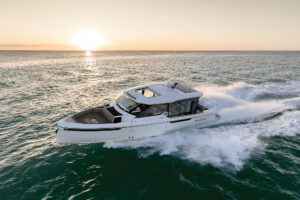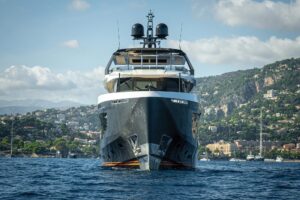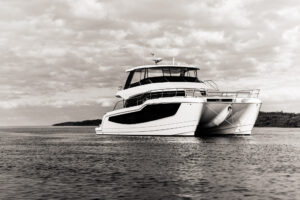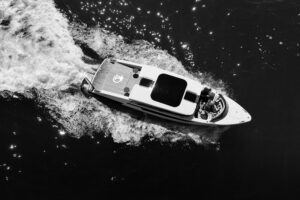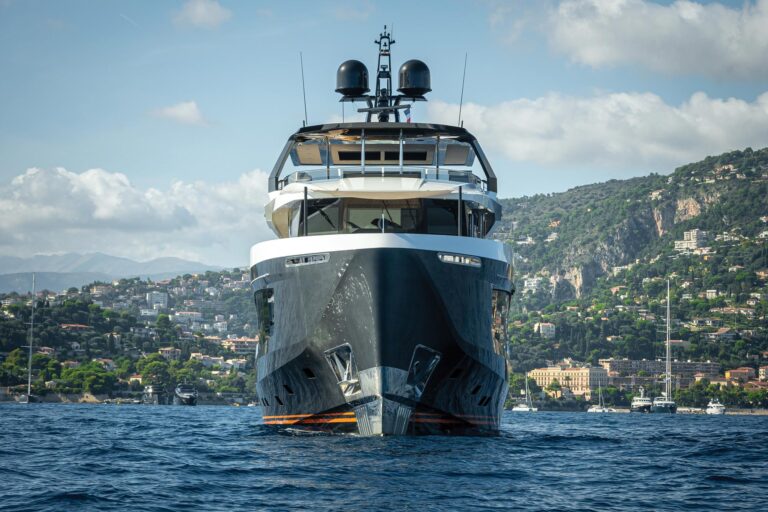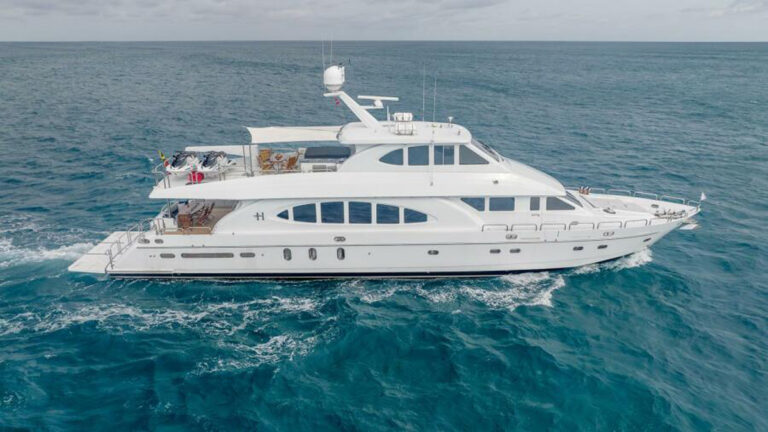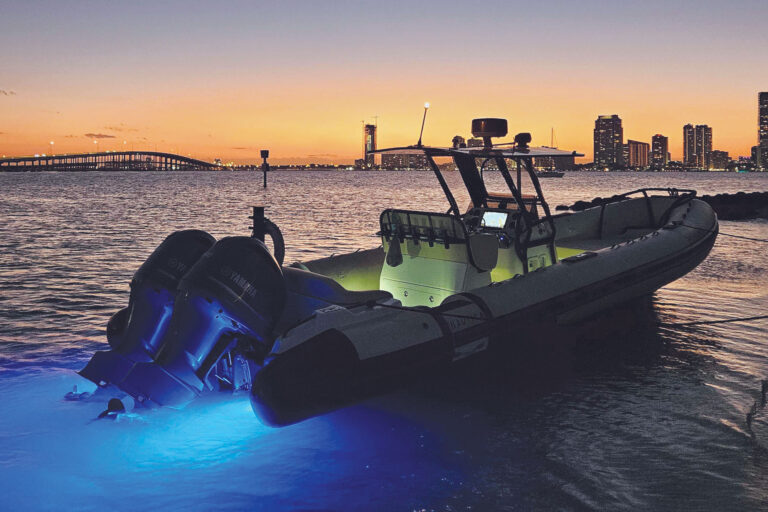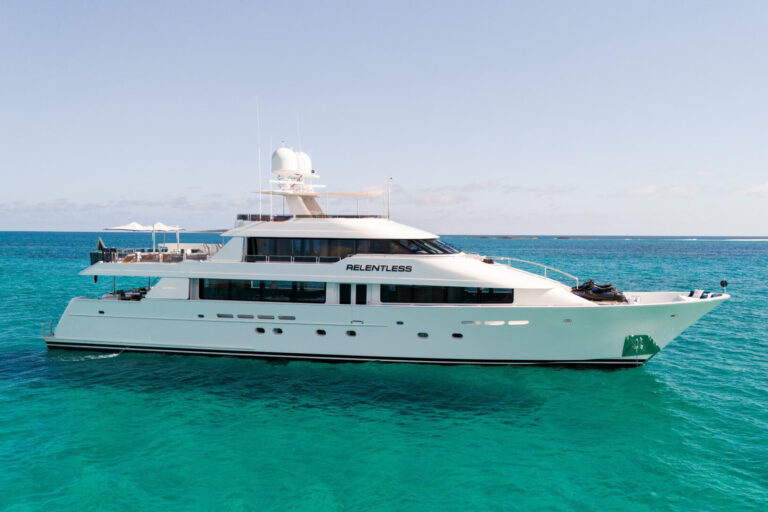Intrepid is an exception-having carved its niche at the upper end of the market with semi-custom small boats built to a level of quality instead of to a level of production volume. Because of this, Intrepid’s new 310 Walkaround is unique, and like her sisters, is in demand.
The 310 is not easily pigeonholed. While she is a capable sportfisherman, she is not an all-out fish boat. While she is not a race-bred open express, her performance matches or exceeds that of other boats in the category. She is true to the multipurpose origins of the open center-console design.
From entry-level offerings to top-shelf brands, dozens of console boats fill the market. Usually, consumers measure value by performance and features versus dollars spent. Even with the well-managed inventories common these days, buyers do not have a difficult search to find a relatively quick fix. That is, unless their heart is set on owning an Intrepid.
“We could double the size of our facilities and increase production but we believe that our current pace allows us to take more time with our customers and in turn build them a better boat, says John Michel, founder and CEO of Intrepid. “For us, boatbuilding is a personal thing. In many cases, our customers have become our friends.
Michel’s process yields tangible results. The first thing that caught my eye when I spotted the 310 was her fair hull and exceptional Imron finish. She is built in female tooling and is available with a standard white gelcoat finish, however, most customers opt for custom colors. The boot stripe is also Imron and in some cases outboards are color-coordinated with the hull.
This sparkle only adds to the eye-appeal that is ingrained in her design. Michel is the creative force behind the product. His eye for a good-looking boat has served him well, and his willingness to invest in complicated design elements lends to the 310’s unique look. A boat of this size and type could easily be built with a dozen or so molds. The 310 requires 120 molds. More than half a dozen molds are used to build her shapely center console, which is hand finished with gelcoat.
Most production boatbuilders would not tolerate this sort of investment. Solid design and engineering accompany the extensive tooling. Hatches are finished inside and out, electrical switches are centralized in a drop-down locker and deck fill caps are cleverly hidden in the topsides and transom coaming. Hardware is hearty and wiring and plumbing neat and tidy. The net result is that styling and function complement one another without compromise.
Intrepid blends these standard features with a long list of options that allow customers to create a semi-custom boat. Our test boat, for example, had a dive-door, with an integral ladder, let into the topsides. This is in addition to a transom door and platform. Powder-coated aluminum pipe work and a fiberglass hardtop are integrated seamlessly into the design. The option list is just a starting point: “We see ourselves as a custom-boatbuilder, Michel said.
The helm has plenty of space for electronics and an integral drink box that can be refrigerated. A bolster-style seating console incorporates rodholders, drink holders and a tackle station. A fish/stowage box in the sole is plumbed with a macerator, and there are two live wells in the transom area. Forward of the helm, Intrepid has provided L-shape seating and additional stowage under the cockpit sole.
Her interior has a full fiberglass liner that includes a seating/berth area and a small galley equipped with a stainless-steel sink and a dual-voltage refrigerator. The enclosed head and shower is fitted with an electric toilet hidden in a molded seat. Intrepid offers an optional generator and an air-conditioning system and will grant requests for leather soft goods, carpet, wood cabinetry and Corian countertops.
I toured the builder’s relatively small facility in Largo, Florida. The 310 is built using stitched multidirectional reinforcement and vinylester resin. Divinycell coring is used in the topsides, transom and decks. Stringers are built of the same materials off the boat-cut with a computer-controlled router from panels built on a vacuum-bagging table. Inaccessible areas within the hull are filled with closed-cell foam and sealed. Open bilge spaces are finished with gelcoat.
While Intrepid’s production line is organized in a conventional fashion, things slow down once a boat and its various components are molded and assembled. Hand finishing and the installation of options and custom work consume the bulk of the space on the production floor. Each boat in process carries its life history, specification and owner’s name in a pouch attached to the hull. Owners are encouraged to visit while their boats are under construction.
During my visit, the plant was wall-to-wall with variants of the eight base models Intrepid builds from 30 to 37 feet. Many, according to Michel, are built for folks as second boats and about 20 percent serve as yacht tenders. Michel is also attracting a growing number of customers who are moving down from larger boats. “Outboards have come into their own, Michel said. “They require little attention, don’t mind sitting idle and are extremely reliable; i.e., hassle-free boat ownership.
Intrepid has been perfecting its stepped hull designs for the past 15 years. Michel suggests the 310’s single step configuration was chosen to suit her speed and service. “Our boats are designed to be comfortable and dry in a seaway at moderate speeds (less than 70 mph), Michel said. “A single step configuration is ideal for this application. A chine ledge controls spray forward and is ventilated at the step. Deadrise at the transom is 22 degrees.
I was impressed when running the 310 in a 3-foot chop. She transitions to a plane at about 16 knots and with her twin 300 hp, Yamaha HPDIs trimmed up a bit, she reached a maximum speed of 52.4 knots at 5450 rpm. She tracks well, turns predictably and was dry in all directions. She is well balanced, not overly stiff longitudinally and her trim angle is not too shallow. In stepped hull design this is perfection.
Perfection is what owners of Intrepids seek, and Michel attempts to deliver. While no boat is flawless, I must admit that I could not find fault in the 310. This attention to design and detail has served Michel well. His quasi-custom approach to boatbuilding has nurtured pent-up demand for his product in the new and used markets. Currently, lead-time for a 310 is about 16 months. In my view she’s worth the wait.
Contact: Intrepid Powerboats, (954) 922-7544; www.intrepidboats.com_. _

